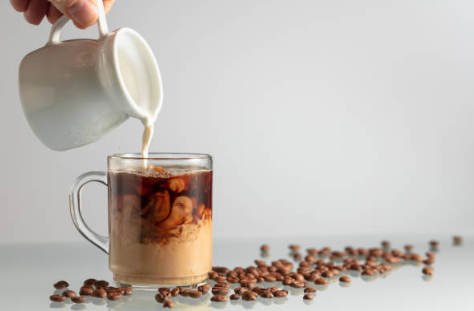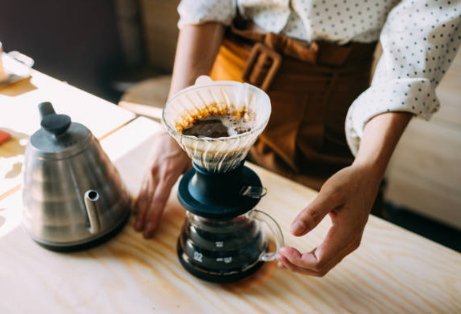Coffee is one of the most consumed beverages worldwide—and the main source of caffeine for millions. In the U.S. alone, we drink roughly 400 million cups every day. Among those are shots of espresso, the concentrated form of coffee that’s either sipped solo or used as the base of your favorite latte.
Let’s break down how espresso and coffee are alike, how they differ, and which one may be the healthier choice.
What Is Espresso?
Espresso is a style of coffee that originated in Italy. It’s made by forcing hot water through finely-ground coffee at high pressure. The result is a small but strong shot of coffee with a bold, rich flavor, deep aroma, and intentionally bitter finish.
Contrary to popular belief, espresso isn’t made from a different type of coffee bean. All coffee—whether it’s a pour-over or a shot of espresso—comes from roasted beans harvested from coffee trees. There’s no such thing as an “espresso tree.”
What sets espresso apart is how the beans are roasted and brewed. Espresso beans are roasted longer and at higher temperatures, resulting in a darker roast that brings out a deeper, smokier flavor.
Caffeine Content:
A 1-ounce (about 30 mL) shot of espresso contains roughly 63 mg of caffeine. The FDA recommends limiting caffeine intake to no more than 400 mg per day, which equals about 6 single shots of espresso, assuming you’re not caffeine-sensitive.
What Is Coffee?
“Coffee” is a broader category and can be brewed in many ways—drip machines, pour-over cones, French presses, and more. The process is generally low-pressure and uses more water to extract flavor from medium- to coarsely-ground beans.
Unlike the bold intensity of espresso, drip coffee has a milder flavor profile with more acidity and less bitterness. A standard serving size is about 8 ounces (237 mL), though many coffee shop sizes range from 12 to 20 ounces or more.
Caffeine Content:
An 8-ounce cup of brewed coffee contains roughly 92 mg of caffeine. So to reach the 400 mg daily limit, you’d need to drink about 4 regular cups.
Which One Has More Caffeine?
The biggest difference between espresso and coffee is how they’re brewed, which directly affects caffeine content.
Espresso is more concentrated—so per ounce, it contains more caffeine than regular coffee. But because we typically drink espresso in smaller servings, a single shot of espresso has less total caffeine than a full cup of coffee.
For example:
-
1 oz espresso = 63 mg caffeine
-
8 oz drip coffee = 92 mg caffeine
-
A large (20 oz) coffee? Around 230 mg caffeine
-
A double shot of espresso (in your latte)? Around 126 mg caffeine
Which One Is Healthier?
Both espresso and brewed coffee contain beneficial plant compounds—including antioxidants and polyphenols—that can offer health benefits when consumed in moderation.

One standout compound is chlorogenic acid, which has anti-inflammatory properties and supports heart health, metabolism, and brain function. Because of these compounds, coffee consumption has been linked to reduced risk of heart disease, improved cognitive function, and even longer lifespan.
That said, chlorogenic acid levels decrease the longer coffee beans are roasted. So lighter roasts tend to retain more of these beneficial compounds than dark roasts—meaning your regular drip coffee (often light to medium roast) may contain more health-promoting compounds than deeply roasted espresso beans.
A study in The European Journal of Nutrition found that people who drank more than three cups of coffee a day had lower BMI, waist size, blood pressure, and triglycerides—and higher levels of HDL cholesterol—compared to those who drank less than one cup a day.
How Much Should You Drink?
So how much is ideal? After reviewing 201 studies, researchers found that drinking three to four cups of coffee per day offered the greatest health benefits compared to non-coffee drinkers. But remember—coffee is just one part of a healthy lifestyle.
How They’re Made
Drip Coffee:
Brewing methods vary, but most people use drip machines: fill the reservoir with water, scoop ground coffee into a paper filter, and let the machine do the rest. For French press, you steep coarsely-ground coffee in hot water for 4 minutes, then press it through a mesh filter.
Espresso:
Espresso requires a more specialized setup. You’ll tamp finely ground coffee into a metal filter basket (portafilter), lock it into a machine, and extract the espresso under high pressure—usually in 20–30 seconds. Any roast can technically be used, but dark roasts are preferred for espresso because they deliver the boldest flavor.
Enjoying Coffee the Healthy Way
Now that we know both espresso and regular coffee can support a healthy lifestyle, let’s talk about what not to do:
-
Skip the sugar. Avoid adding refined sugar or artificial sweeteners, which can harm your metabolism or gut health.
-
Watch your timing. Try to stop drinking caffeine by early afternoon—especially if you’re sensitive. Caffeine too late in the day can disrupt your sleep, which plays a critical role in immune health and metabolism.
-
Know your limits. Everyone processes caffeine differently, so listen to your body and stick within the 400 mg daily guideline.
The Bottom Line:
Espresso and coffee aren’t as different as you might think—they’re made from the same beans, just brewed differently. Both offer similar health benefits, but light and medium roast drip coffee may edge out espresso when it comes to antioxidants and heart-friendly compounds.
To get the benefits without the downsides, limit added sugar, drink your coffee earlier in the day, and enjoy it as part of a healthy, balanced lifestyle.

